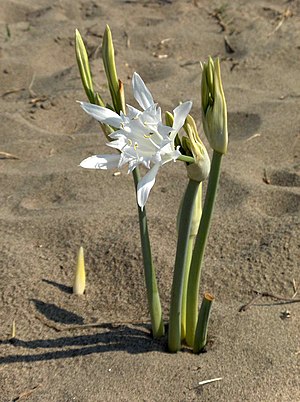Pancratium maritimum: Difference between revisions
Ζωῆς πονηρᾶς θάνατος αἱρετώτερος → Satius mori quam calamitose vivere → Dem schlechten Leben vorzuziehen ist der Tod
m (Text replacement - "(==Translations==)(?s)(\n)(.*)($)" to "{{trml |trtx=$3 }} ") |
mNo edit summary |
||
| Line 1: | Line 1: | ||
{{lael | {{lael | ||
|lgtx=[[παγκράτιον]] | |lgtx=[[παγκράτιον]], [[ἐριοφόρος βολβός]] | ||
}} | }} | ||
==Wikipedia EN== | ==Wikipedia EN== | ||
Revision as of 17:51, 8 October 2022
Latin > Greek
Wikipedia EN
Pancratium maritimum, or sea daffodil, is a species of bulbous plant native to the Canary Islands and both sides of the Mediterranean region and Black Sea from Portugal, Morocco and the Balearic Islands east to Turkey, Syria, Israel and the Caucasus. In the parts of its range on the south Bulgarian and north Turkish and Georgian coasts of Black Sea. It is also naturalized in southern California, Bermuda and the Azores.
Pancratium maritimum grows on beaches and coastal sand dunes, often with much of the leaves and scapes buried in the sand. Other vernacular names are sea lily, sand daffodil, sand lily and lily of St. Nicholas, (although it is not a true lily). The specific epithet maritimum means "of the sea".
Translations
ar: طيطان بحري; arz: طيطان بحرى; bg: пясъчна лилия; ca: lliri de mar; co: gigliu di mare; de: Dünen-Trichternarzisse; el: κρίνος της θάλασσας; grc: παγκράτιον; et: rand-vägilill; eu: itsas lilipa; fa: نرگس دریایی; fi: hietamerinarsissi; fr: lis maritime; he: חבצלת החוף; hy: ծովանարգես; ka: ზღვის შროშანი; la: Pancratium maritimum; pl: pankracjum nadmorskie; ru: панкраций морской; sv: strandlilja; tr: kum zambağı

